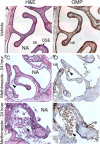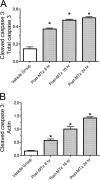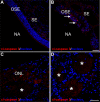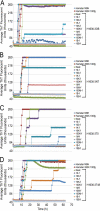Accelerated shedding of prions following damage to the olfactory epithelium
- PMID: 22130543
- PMCID: PMC3264367
- DOI: 10.1128/JVI.06626-11
Accelerated shedding of prions following damage to the olfactory epithelium
Abstract
In this study, we investigated the role of damage to the nasal mucosa in the shedding of prions into nasal samples as a pathway for prion transmission. Here, we demonstrate that prions can replicate to high levels in the olfactory sensory epithelium (OSE) in hamsters and that induction of apoptosis in olfactory receptor neurons (ORNs) in the OSE resulted in sloughing off of the OSE from nasal turbinates into the lumen of the nasal airway. In the absence of nasotoxic treatment, olfactory marker protein (OMP), which is specific for ORNs, was not detected in nasal lavage samples. However, after nasotoxic treatment that leads to apoptosis of ORNs, both OMP and prion proteins were present in nasal lavage samples. The cellular debris that was released from the OSE into the lumen of the nasal airway was positive for both OMP and the disease-specific isoform of the prion protein, PrP(Sc). By using the real-time quaking-induced conversion assay to quantify prions, a 100- to 1,000-fold increase in prion seeding activity was observed in nasal lavage samples following nasotoxic treatment. Since neurons replicate prions to higher levels than other cell types and ORNs are the most environmentally exposed neurons, we propose that an increase in ORN apoptosis or damage to the nasal mucosa in a host with a preexisting prion infection of the OSE could lead to a substantial increase in the release of prion infectivity into nasal samples. This mechanism of prion shedding from the olfactory mucosa could contribute to prion transmission.
Figures








Similar articles
-
Prion shedding from olfactory neurons into nasal secretions.PLoS Pathog. 2010 Apr 15;6(4):e1000837. doi: 10.1371/journal.ppat.1000837. PLoS Pathog. 2010. PMID: 20419120 Free PMC article.
-
Lesion of the olfactory epithelium accelerates prion neuroinvasion and disease onset when prion replication is restricted to neurons.PLoS One. 2015 Mar 30;10(3):e0119863. doi: 10.1371/journal.pone.0119863. eCollection 2015. PLoS One. 2015. PMID: 25822718 Free PMC article.
-
Transmission of CJD from nasal brushings but not spinal fluid or RT-QuIC product.Ann Clin Transl Neurol. 2020 Jun;7(6):932-944. doi: 10.1002/acn3.51057. Epub 2020 Jun 15. Ann Clin Transl Neurol. 2020. PMID: 32538552 Free PMC article.
-
Improving the Predictive Value of Prion Inactivation Validation Methods to Minimize the Risks of Iatrogenic Transmission With Medical Instruments.Front Bioeng Biotechnol. 2020 Dec 1;8:591024. doi: 10.3389/fbioe.2020.591024. eCollection 2020. Front Bioeng Biotechnol. 2020. PMID: 33335894 Free PMC article. Review.
-
Photodegradation illuminates the role of polyanions in prion infectivity.Prion. 2011 Apr-Jun;5(2):49-51. doi: 10.4161/pri.5.2.16155. Epub 2011 Apr 1. Prion. 2011. PMID: 21646861 Free PMC article. Review.
Cited by
-
A test for Creutzfeldt-Jakob disease using nasal brushings.N Engl J Med. 2014 Aug 7;371(6):519-29. doi: 10.1056/NEJMoa1315200. N Engl J Med. 2014. PMID: 25099576 Free PMC article.
-
Host Determinants of Prion Strain Diversity Independent of Prion Protein Genotype.J Virol. 2015 Oct;89(20):10427-41. doi: 10.1128/JVI.01586-15. Epub 2015 Aug 5. J Virol. 2015. PMID: 26246570 Free PMC article.
-
Axonal and transynaptic spread of prions.J Virol. 2014 Aug;88(15):8640-55. doi: 10.1128/JVI.00378-14. Epub 2014 May 21. J Virol. 2014. PMID: 24850738 Free PMC article.
-
Very low oral exposure to prions of brain or saliva origin can transmit chronic wasting disease.PLoS One. 2020 Aug 20;15(8):e0237410. doi: 10.1371/journal.pone.0237410. eCollection 2020. PLoS One. 2020. PMID: 32817706 Free PMC article.
-
Prion disease and the innate immune system.Viruses. 2012 Dec;4(12):3389-419. doi: 10.3390/v4123389. Viruses. 2012. PMID: 23342365 Free PMC article. Review.
References
-
- Apter AJ, Gent JF, Frank ME. 1999. Fluctuating olfactory sensitivity and distorted odor perception in allergic rhinitis. Arch. Otolaryngol. Head Neck Surg. 125:1005–1010 - PubMed
-
- Atarashi R, et al. 2008. Simplified ultrasensitive prion detection by recombinant PrP conversion with shaking. Nat. Methods 5:211–212 - PubMed
-
- Bahrami F, van Hezik C, Bergman A, Brandt I. 2000. Target cells for methylsulphonyl-2,6-dichlorobenzene in the olfactory mucosa in mice. Chem. Biol. Interact. 128:97–113 - PubMed
-
- Balkema-Buschmann A, et al. 2011. BSE infectivity in the absence of detectable PrP(Sc) accumulation in the tongue and nasal mucosa of terminally diseased cattle. J. Gen. Virol. 92:467–476 - PubMed
Publication types
MeSH terms
Substances
Grants and funding
LinkOut - more resources
Full Text Sources
Other Literature Sources
Research Materials

